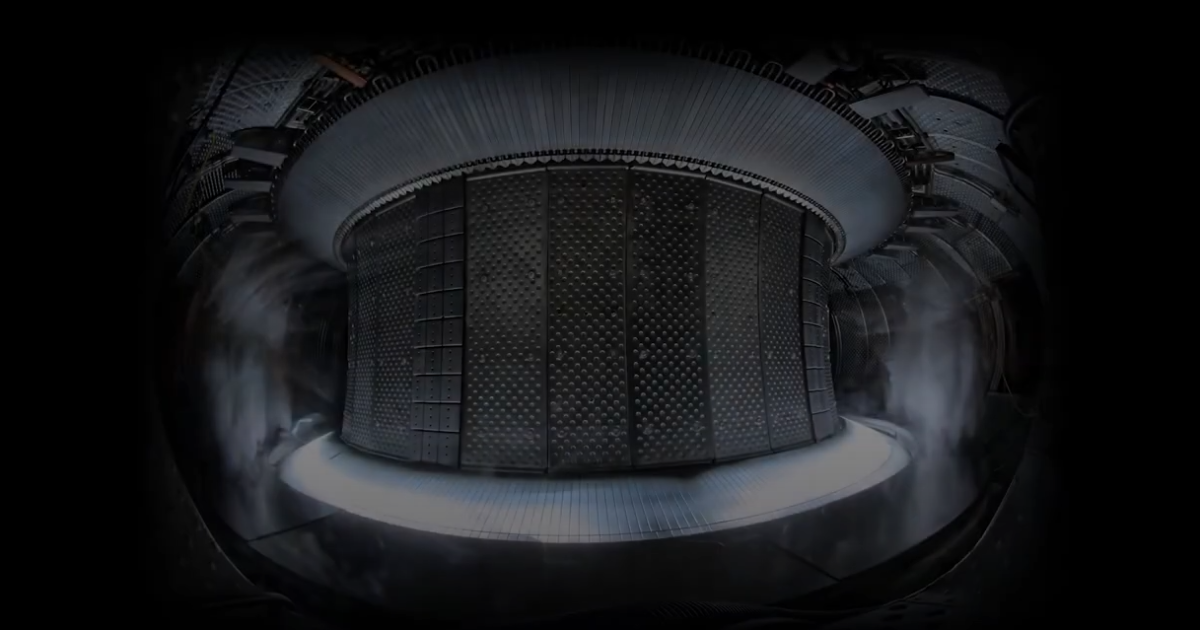1,337 seconds


5,318008 seconds should be a new goal.
Le et
Flexing
Flexing is not good for the containment
No, but some guy proved that we could use that to our advantage. If you don’t use the magnetic constrictors to compensate for the heat from the fusion expanding the vessel, you can have it enter fusion and leave fusion several times a second. Wrap the thing in copper wire coils, and you have now got your vessel in a state of flux, and producing enough power to blackout your local grid, and get lots of fines from the feds in less than 5 seconds of runtime. He obviously didn’t continue working on that particular method of generating power with a Tokomak
Can you link to something so I can read more about this please?
Wish I could. Only reason I know about it, is that it was mentioned briefly in the Navy Nuclear Power Program training materials.
Rumor is next they are trying for 11.6858˙3 hours
Elven time conversion is the worst.
I didn’t see any mention of the output in the article. 22MW injected, but does anyone know if the reaction was actually generating a positive output?
Sounds like the goal of the test wasn’t to vet ignition power in relation to output. These people are testing the durability of system designs that can maintain a reaction after ignition.
If this was a car, they wouldn’t be testing the fuel efficiency, they’d be testing how long they could drive before the wheels fell off.
No magnetic confinement fusion reactor in existence has ever generated a positive output. The current record belongs to JET, with a Q factor of 0.67. This record was set in 1997.
The biggest reason we haven’t had a record break for a long time is money. The most favourable reaction for fusion is generally a D-T (Deuterium-Tritium) reaction. However, Tritium is incredibly expensive. So, most reactors run the much cheaper D-D reaction, which generates lower output. This is okay because current research reactors are mostly doing research on specific components of an eventual commercial reactor, and are not aiming for highest possible power output.
The main purpose of WEST is to do research on diverter components for ITER. ITER itself is expected to reach Q ≥ 10, but won’t have any energy harvesting components. The goal is to add that to its successor, DEMO.
Inertial confinement fusion (using lasers) has produced higher records, but they generally exclude the energy used to produce the laser from the calculation. NIF has generated 3.15MJ of fusion output by delivering 2.05MJ of energy to it with a laser, nominally a Q = 1.54. however, creating the laser that delivered the power took about 300MJ.
I wasn’t aware of that distinction about the energy for the laser to generate the heat energy within the reaction not being factored into the Q value, very interesting, thank you! Would that energy for the laser still be required in a “stable reaction” continuously, or would it be something that would “trail off”?
In my experience the community will usually distinguished between “scientific Q” and “wall plug Q” when discussing fusion power gain. Scientific is simply the ratio of power in vs power out, whereas wall plug includes all the power required to support scientific Q. Obviously the difference isn’t always clearly delineated or reported when talking to journalists…
Inertial confinement doesnt produce a “stable reaction” it is pulsed by it’s nature, think of it in the same way as a single cylinder internal combustion engine, periodic explosions which are harnessed to do useful work. So no the laser energy is required every single time to detonate the fuel pellet.
NIF isnt really interested in fusion for power production, it’s a weapons research facility that occasionally puts out puff pieces to make it seem like it has civilian applications.
Your take is incorrect.
It would be more productive if you said how you think im wrong. Just saying ‘youre wrong’ doesnt really add anything to the discussion.
If you haven’t already seen the talk recently given at the Chaos Computer Club’s “Hacker Hotel” named “How Thermonuclear fusion works, free energy without waste”, I highly recommend it. https://libranet.de/display/0b6b25a8-ff152736-e38872dd7aed088e
The input energy doesnt matter that much. Nobody is going to use 1980s laser tech to power a real reactor. As with OP, inertial confinement is interested in very small nuanced science aspects, not making a power plant.
I’ve seen a few mentions of positive output in the last few years.
OK, so we should be clear there are broadly two approaches to fusion: magnetic confinement and inertial drive.
In magnetic confinement a plasma is confined such that it can be driven to sufficient density, temperature and particle confinement time that the thermal collisions allow the fuel to fuse. This is what the OP article is talking about. This Tokamak is demonstrating technologies that if applied to a larger the experiment could probably reach a positive energy output magnetically confined plasma.
The article you referenced discusses inertial drive experiments, where a driver is directly pushing the fuel together, like gravity in the sun, a fission bomb shockwave in a hydrogen bomb, or converging laser beams in Livermore’s case.
Livermore’s result is exciting, but has no bearing on the various magnetic confinement approaches to fusion energy.
Article said 2.6GJ input, 2.6 output so 1Q, but I’m not certain it’s really the case.Edit: I can’t find my source back, so it’s likely false
I hope it smoked a cigarette once it finished.
How ks the drill baby drill crowd going to compete against mini stars in a can?
Lmao. Fucking oil losers
A headline without calling it an “Artificial Sun”?!
The amusing thing is that the sun is actually quite a shit fusion reactor. It’s power per unit volume is tiny. It just makes it up in sheer volume. A solar level fusion reactor would be almost completely useless to us. Instead we need to go far beyond the sun’s output to just be viable.
It’s like describing one of the mega mining dumper trucks as an “artificial mule”.
I think this energy density math really depends on whether only the core or the whole surface area is taken into consideration.
Even the core only has an output of 200-300W/m^3.
That’s about the energy output per volume of a 70 year old cyclist.
Right, for the Americans here that hate metric.
Cyclist-years is a unit that has served us well for generations
Arguably, the nearby sun scale fusion reactor has been fairly useful for us. Nowadays we can convert its output directly into electricity using solar cells
I never said it wasn’t useful, just a very low efficiency reactor. Then again, if it was better, it would burn out faster, which would be bad for life on earth.
It produces about the same power per cubic metre as compost does, which is pretty crazy when you think about it.
What I’m hearing is that we should mine the sun and make better use of all that fuel.
Just make sure you do it at night.
That’s part of the reason a moon base could be viable. The sun outputs a reasonable amount of helium 3, which is great for fusion reactions. Unfortunately it tends to sit at the top of our atmosphere and get blown away again. On the moon, it gets captured by the dust in collectable quantities.
Someone once told me a sun is just a fusion nuclear pile reactor and… Like… I guess.
Sure, but it makes up for that by having an idiot proof design.
Or a “star in a bottle”
A bulb in a bong
The power of the sun in the palm of my hand.
Don’t worry, it will stabilize
@Toribor @notsoshaihulud with great power comes great responsibility
They say “artificial sun” because that’s what it is though, there’s no fusion reactions here they’re just microwaving hydrogen to millions of degrees to study the kind of thing that would happen IF somebody runs a fusion reactor for 22 minutes.
Removed by mod
Which lemmy client are you using? Your reply has
Check out more details here: <a href=“https://markdown-viewer.com/”>markdown viewer</a>.
And visiting the website is a mess as well
Meanwhile in America we’re trying to make macdonalds cheaper by bundling an extra sandwich to go along with a value meal…
That’s called McFusion
And it only takes 22 seconds to consume.
And only 12 seconds to regret.
That’s way better than Taco Bell, where the regret sinks in when you consider going there.
Spoken like someone who’s never had a cheesy gordita crunch
Oh I have, and they’re delicious. I still regret it every time though because of how low quality everything is.
Which means you are still consuming the burger for 10 seconds fully regretting your decision.
110% commitment to the burger and the regret. USA! USA!
And keeps you sated for another 22 seconds.
Then you want seconds.
America would blow up a fusion reacto, call it dangerous, elon musk has a lot of things to say about it and then it would be illegal worldwide. Have you guys heard about coal? We already fixed it, just burn coal.
When the fuck did maccas start doing a sandwich?
Day one? A hamburger is a sandwich.
That was such a culture shock when I went to the us for the first time.
In Germany and many places in Europe do not think of burgers as sandwiches. I was so confused when I ordered a sandwich and got something like a burger.

I expected something like this. My confusion must’ve been quite the sight, the waitress even seemed concerned. Tasted great though.
Only difference between that and a burger is a burger is usually on a roll, not slices of bread. (And a burger is always hot, but then so are some sandwiches.)
Mr. Fusion now 1 step closer… 10 years late, but still!
Only ten more years, and we’ll have it!
I feel like the awesome back to future reference was missed completely.
…you said 10 more years 50 years ago
In just 10 more years, it’ll only be 40 more years!
So, some as graphene.
We’re using graphene! Almost entirely for it’s electrical properties true, but we’re using graphene doped batteries in consumer electronics currently. We also use fusion and ITER research for a whole lot more than just power generation - plasma dynamics, just one tiny subfield concerned with physics, has applications in everything from radio transmission beam forming techniques to satellite engines to magnetodynamic modeling to the EMI shielding on your vacuum cleaner.
I would like to subscribe for more graphene facts.
This is cool but also remember the practicalities of Fusion make it not much better than nuclear:
not to say its the greatest form of energy production ever, but, what are your gripes with nuclear these days anyway?
Well, really it’s the opposite, nuclear works already. So why not just build nuclear plants at 1/20 the cost? (and actually get some net positive energy)
Just saying…
this (specific project) isn’t about harvesting energy…
I understand that, it can’t be. Because fusion power generation hasn’t all been worked out yet. Unlike fission. That’s my point.
Also, once fusion does work, it will still be the most expensive way to generate energy man has ever devised, so there’s that too.
None! My comment may be misunderstood.
If you’re of my generation you kind of grew up being told fusion energy was the holy grail of energy production as it’s clean and doesn’t produce a bunch of radioactive byproduct. (Stuff like SimCity etc. made fusion reactors seem like a miracle technology)
In reality fusion also produces a massive amount of radiation and radiative byproducts, so it’s not the holy grail of energy that I think most people might assume it is.
Fusion and Fission are two sides of the same coin, so fusion experiments are important because they aid in making fission reactors safe as well!
I’m especially looking forward to seeing how material scientists attempt to solve the massive fast neutron radiation that fusion reactors produce, as Thorium reactors have the same issue.
if I remember correctly, the output of a nuclear fission reactor can be used in a nuclear fusion reactor for a near-net zero loss in materials.
there’s like three different fusion reactors, so it’s likely one of the three that can do this, but still better than fossil fuels.
no. that’s thermodynamically impossible.
though it is true that fission and fusion are opposites, you cannot gain energy by fissing and fusing the same material. There’s an inverted bell curve where medium sized elements are the lowest energy state. You can get energy by making atoms more medium, fusing the smallest atoms or fissing the biggest ones. Doing the opposite costs energy.
The primary issue is that deuterium-deuterium reactions (the only practical fusion process that seems to work is deuterium-tritium and deuterium-helium, as you need insane temperatures for proton-boron, so in any realistic reactor deuterium will end up reacting with itself) produce 3 times the radiation of equivalent power output from fission reactions, so you need MASSIVE amounts of shielding for a reactor to run for an extended period of time.
This also highly irradiates the materials inside the reactors themselves, to a degree that maintenance requires built-in robots because the inside of the reactor is too radioactive for humans (this also eventually destroys the robots). The most optimistic estimates for how long a reactor could possibly last is 100 years. At that point the entire reactor would need to be torn down and buried because most of the components would be too radioactive to use anymore. At which point you have the exact same issue as radioactive waste storage, but no recycling process for something crazy like a radioactive isotope of silicon.
However! That’s why these experiments are important! As every advancement they make towards making fusion safe, also makes fission safer, as they’re two sides of the same coin.
Well nuclear is great, so even “not much better” would be great.
Yea one of the most interesting applications of fusion reactor research is the requirements in advancements for material science also benefits fission and even solar power generation, so the research bears fruit well and above the stated goals.
Why don’t we use “shatters world record” like the pro-China articles where they did this for 16 minutes?
I know why.
Dumbass lol
Because that one was over double the length of the record before it and this one is closer to a 35% increase.
So it’s probably just a “slams”
‘Boinks’
whopping
France bamboozles chinas nuclear reactor time with a steel chair
Why do you care so much what an article says about France’s accomplishments of science and China’s accomplishments of science? Why can’t we enjoy the movement of technology without bickering about lines drawn in the sand by people none of us know or care about?
They’ll never tell.
I know!
Because the articles were written by different people and published in different magazines ya goober.
Nah.
It’s because of the Chinese propaganda machine.
Is it because of the Uyghurs?
Has DOGE cut funding to ITER yet?
They sacked everybody. Now they are trying to get them back.
/s
But only the white middle aged men with regular male names and above average height.
What about my racist and misogynist views I try to hide underneath my crazed and incompetent rantings about DEI? Is there room for someone like me?
You are now leading the department.
This is freaking awesome. Only a few years ago it was exciting to see a fusion reaction last a fraction of a second.
It is awesome. Whichever country develops it first will be remembered as the next ‘moon landing’ event forever.
So a big event without any practical relevance because there is more cheaper, reliable and safer alternatives available?
To moon landing, maybe. To fusion, no.
So much has manifested in the ripple effects from the pursuit of great things.
Wait, what is the cheaper alternative to the moon landing?
Rovers as opposed to humans. Humans need food, a pressurized, temperated air environment, a discharge for their excrements, a higher level of safety and return mechanisms, much stronger radiation protection…
The space race gave us space age materials and advances. It wasn’t for nothing.
People fall off rooftops fitting solar panels, burn to death repairing wind turbines that they can’t climb down fast enough to escape, and dams burst and wash away towns. Renewable energy is much less killy than fossil fuels, but per megawatt hour, it’s comparable to nuclear, despite a few large incidents killing quite a lot of people each. At the moment, over their history, hydro is four times deadlier than nuclear, wind’s a little worse than nuclear, and solar’s a little better. Fission power is actually really safe.
The article’s talking about fusion power, though. Fission reactions are dangerous because if you’ve got enough fuel to get a reaction at all, you’ve got enough fuel to get a bigger reaction than you want, so you have to control it carefully to avoid making it too hot, which would cause the steam in the reactor to burst out and carry chunks of partially-used fuel with it, which are very deadly. That problem doesn’t exist with fusion. It’s so hard to make the reaction happen in the first place that any problem just makes the reaction stop immediately. If you somehow blew a hole in the side of the reactor, you’d just get some very hot hydrogen and very hot helium, which would be harmless in a few minutes once they’d cooled down. It’s impossible for fusion power, once it’s working, not to be the safest way to generate energy in history because it inherently avoids the big problems with what is already one of the safest ways.
Oh shit. Things are heating up in the fusion race.
IIRC it was expected because previous record from China was essentially a trial for this one. It all happens under ITER project so it’s not that much of a race.
Good shit. I’d rather this be a global cooperative effort rather than a jingoistic dick-waving contest.
It’s several cooperative and competitives projects. Diversity is not bad for science anyway. ITER itself involve tons of countries.
Good. The only thing that was
quiteremotely good about the cold war was the competition.That’s not what this is, and even then, that competition wasn’t even good. You had two countries hoarding technological advancements for themselves, with everything having to be discovered twice.
This is a worldwide collaboration, where each assists the others, and it’s a much better way of making progress. See ITER.
I should’ve replaced ‘quite’ with a more clear ‘remotely’ but you’re absolutely correct
deleted by creator
Wth is this comment?
A reasonable question.
I haven’t read the original comment and don’t know anything about how conversations work but would it not be easier to Google chatgpt?
deleted by creator
I read through it for the details.
It was net negative, requiring 2MW of power to maintain hydrogen plasma in a state analogous to fusion. The major achievement of this particular experiment was doing so without energies equivalent to a fusion reaction damaging the containing assembly.
It was purely a test/demonstration of the containment of fusion-like conditions.
Thanks for this TLDR. I’m too high to read actual things.
You need to be the right amount of high to properly understand fusion. Too far either way, and it doesn’t make sense.
Eh, fusion isn’t that complicated. You push things together and heat them up until they get even hotter on their own. That’s all that’s happening.
France’s 22-minute plasma reaction is a bold stride toward sustainable fusion energy but remains experimental.
🐱🐱🐱🐱
























